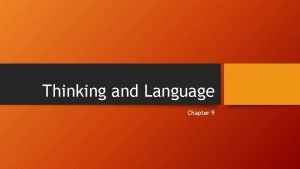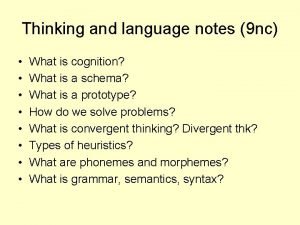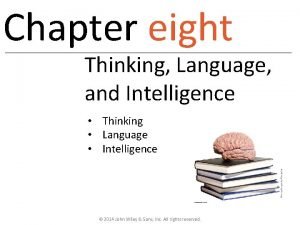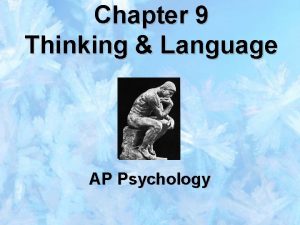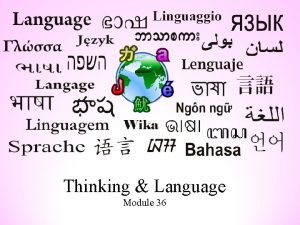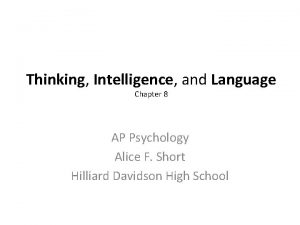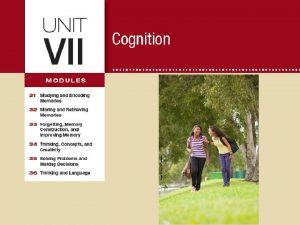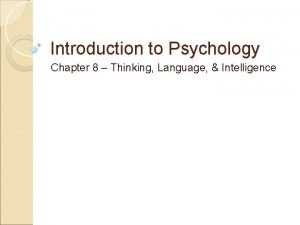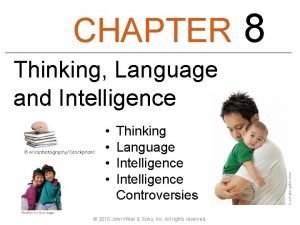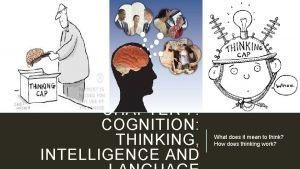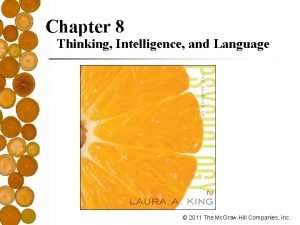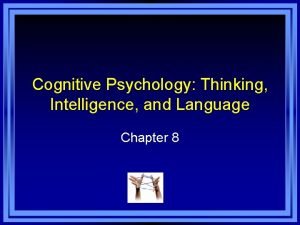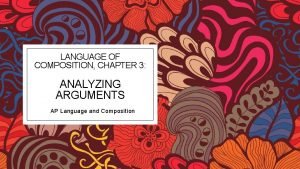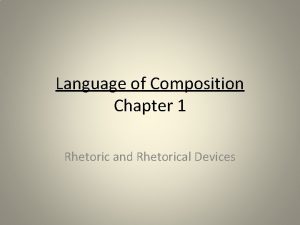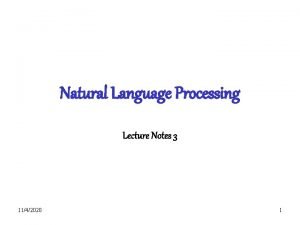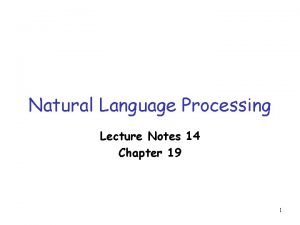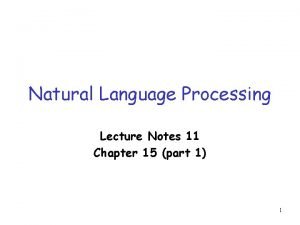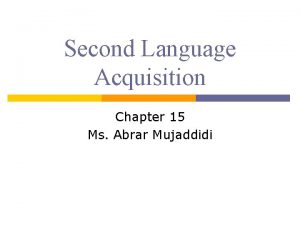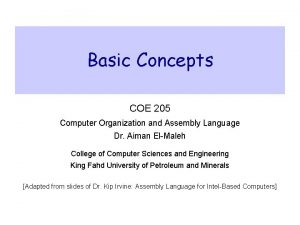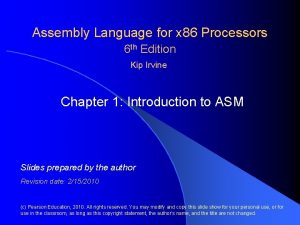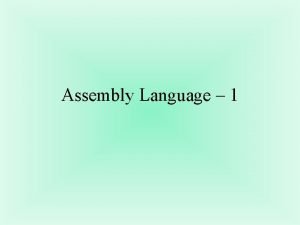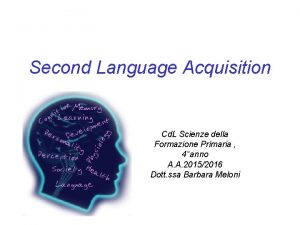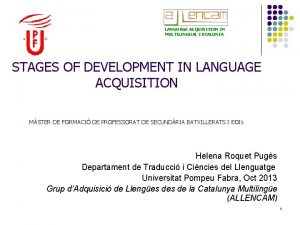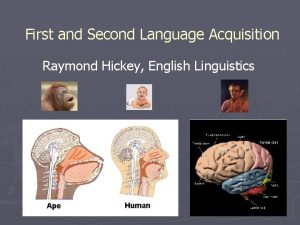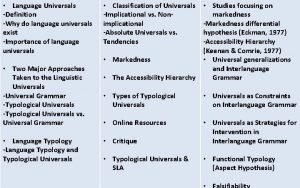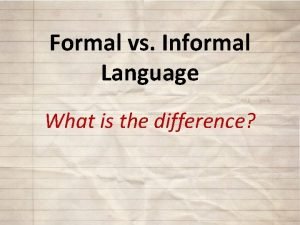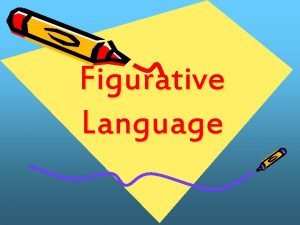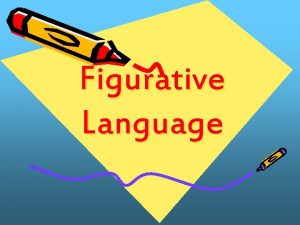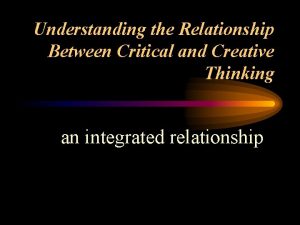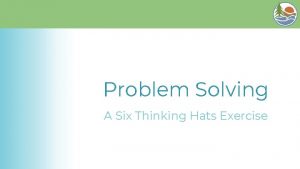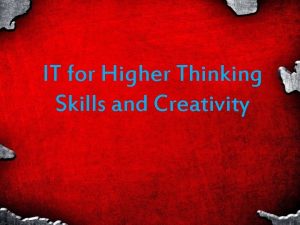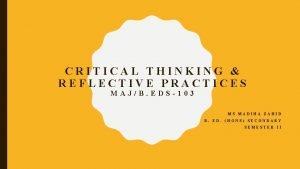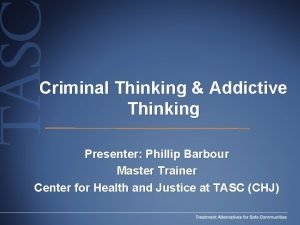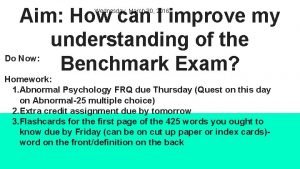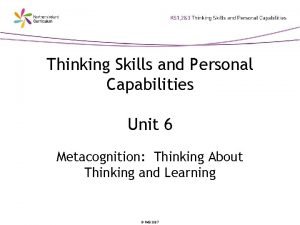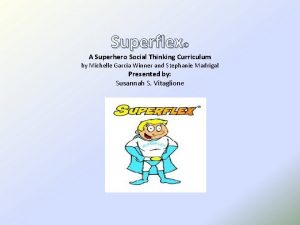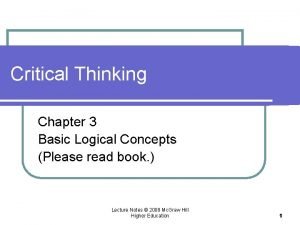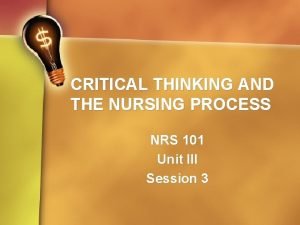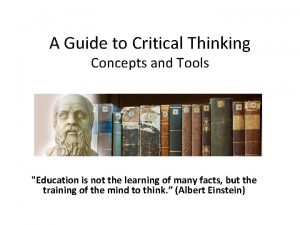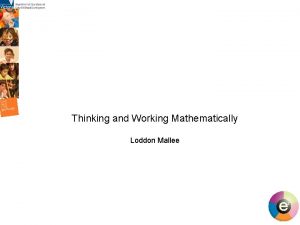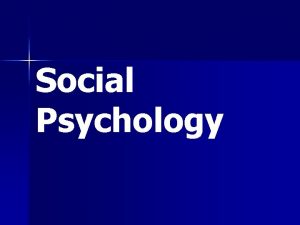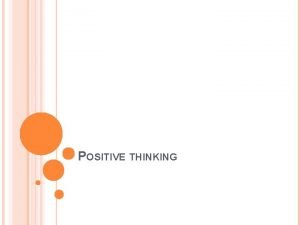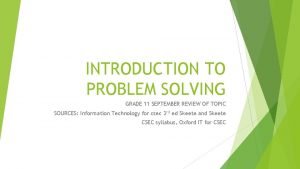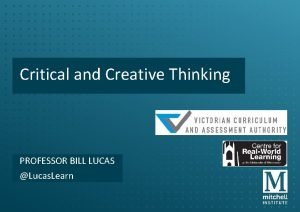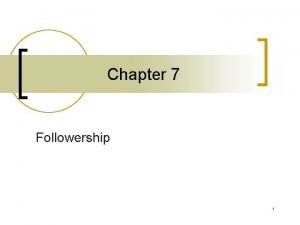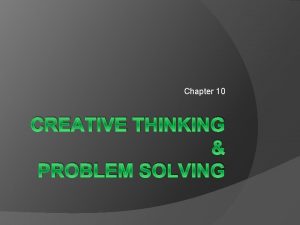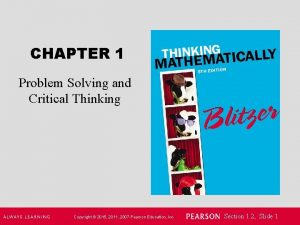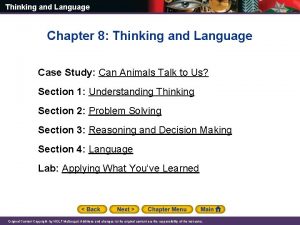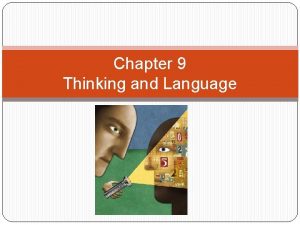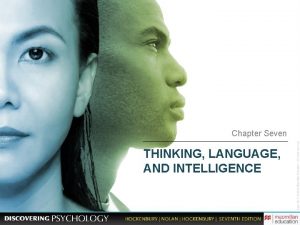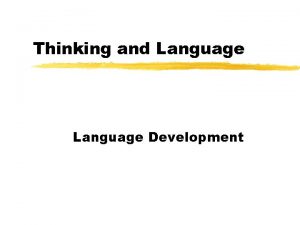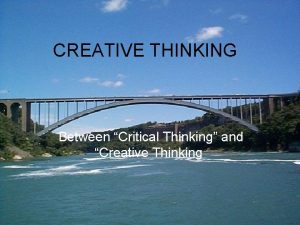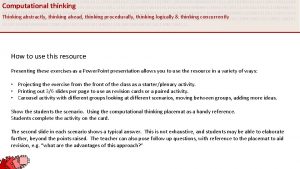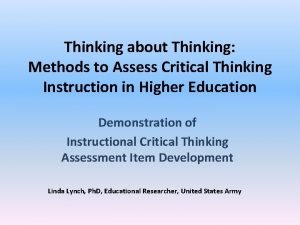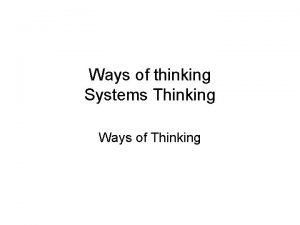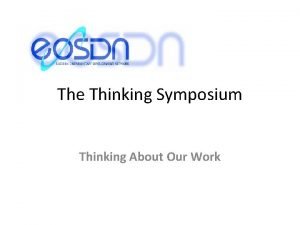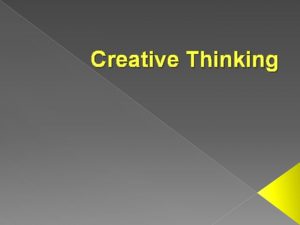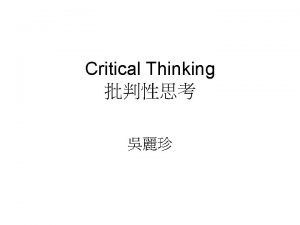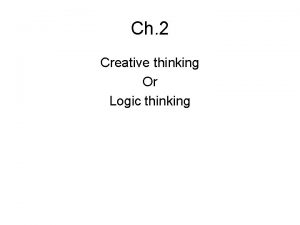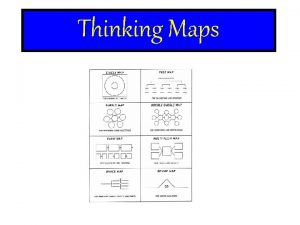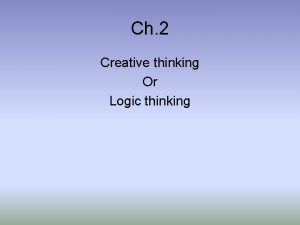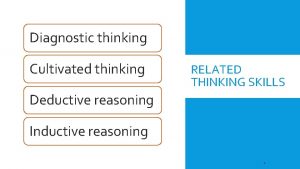Thinking and language notes 9 nc What is













































































- Slides: 77

Thinking and language notes (9 nc) • • What is cognition? What is a schema? What is a prototype? How do we solve problems? What is convergent thinking? Divergent thk? Types of heuristics? What are phonemes and morphemes? What is grammar, semantics, syntax?

Thinking and Language stolen from appsychology. com

Cognition • Another term for thinking, knowing and remembering Does the way we think really matter? Maybe by studying the way we think, we can eventually think better.

In order to think about the world, we form……. . Concepts • A mental grouping of similar objects, events, ideas or people. • Concepts are similar to Piaget’s idea of…. Schemas These animals all look different, but they fall under our concept of “dogs”.

What is a schema? • A schema is a set of ideas about something. Our stereotypes come from our schemas. • What is your schema for an office?

• People were asked what they remembered about this picture. • 29 out of 30 recalled Chair, desk, and walls • Only 8 subjects recalled it had a skull • 9 subjects recalled it had books which it did not • Memory for location is influenced by the person’s schema for that location.

We base our concepts on …. Prototypes • A mental image or best (typical) example of a category. • If a new object is similar to our prototype, we are better able to recognize it. • Which bird is a prototypical bird?

How do we solve problems?

Trial and Error

Algorithms • A rule that guarantees the right solution to a problem. • Usually by using a formula. • They work but are sometimes impractical.

Guess my phone number using an algorithm. • • • 000 -0000 000 -0001 000 -0002 000 -0003 000 -0004 Algorithms are slow, but eventually accurate. Computers use algorithms.

Heuristics Who would you trust to baby-sit your child? • A rule-of-thumb strategy that often allows us to make judgments and solve problems efficiently. A short cut (that can be prone to errors). • Who would you trust to baby sit your child? Your answer is based on your heuristic of their appearances.

Heuristics • A rule of thumb that generally, but not always, can be used to make a judgment to solve a problem. • It’s a short cut. • It is fast, but is… • Prone to errors

Guess my phone number using a heuristic. • Since I live in this area, you can guess my number begins with 214, 972, or 469. Then the fun will begin.

Unscramble this word using a heuristic • euqne • Since q and u always go together, you put them together as a shortcut. Then you figure out the rest.

Insight • A sudden and often novel realization of the solution to a problem. • No real strategy involved

What are some obstacles to problem solving?

Confirmation Bias • A tendency to search for information that confirms one’s preconceptions. For example, if you believe that during a full moon there is an increase in admissions to the emergency room where you work, you will take notice of admissions during a full moon, but be inattentive to the moon when admissions occur during other nights of the month.

Match Problem Can you arrange these six matches into four equilateral triangles?

Match Problem Fixation • The inability to see a problem from a new perspective.

The Nine-Dot Problem . . Without lifting your pen from the page, can you connect all nine dots with only four lines?

Mental Set • A tendency to approach a problem in a particular way, especially if it has worked in the past. • May or may not be a good thing.

Functional Fixedness • The tendency to think of things only in terms of their usual functions. What are some things I can do with this quarter (other than spend it)?

Barriers: Functional Fixedness • Click here for video Functional fixedness: unable to think of unusual or unique uses for objects

Divergent thinking, Convergent thinking • Divergent thinking is thinking outside the box. It means you are creative in coming up with solutions nobody else came up with. (shocks to build muscle) • Convergent thinking is more conforming but just as good. Sometimes the standard way is the best. (lifting weights to build muscle)

Types of Heuristics (That often lead to errors)

Representativeness Heuristic • A rule of thumb for judging the likelihood of things in terms of how well they match our prototype. • Can cause us to ignore important information. Below is Linda. She loves books and hates loud noises. Is Linda a librarian or a beautician?

Representativeness Heuristic Who went to Harvard? My friend Dan is a smart dude, but did not go to Harvard (but he looks like he did). • If I tell you that Sonia Dara is a Sports Illustrated swimsuit model, you would make certain quick judgments (heuristics) about her…like about her interests or intelligence. • She is an economics major at Harvard University. • Judging a situation based on how similar the aspects are to the prototypes the person holds in their mind. • Like thinking everyone from Rye is preppy, or someone with glasses is nerdy, or a blonde is not smart.

Who would you go to for math tutoring? • Our heuristic thinking will tell us to go to the smoking nerd.

Availability Heuristic Although diseases kill many more people than accidents, it has been shown that people will judge accidents and diseases to be equally fatal. This is because accidents are more dramatic and are often written up in the paper or seen on the news on TV. , and are more available in memory than diseases. • Estimating the likelihood of events based on their availability in our memory. • If it comes to mind easily (maybe a vivid event) we presume it is common.

Tornadoes • People over-estimate the likelihood of getting killed by a tornado because of the availability heuristic.

Overconfidence • The tendency to be more confident than correct. • To overestimate the accuracy of your beliefs and judgments. Considering “overconfidence” do you want to risk 1 million dollars on an audience poll?

Framing • • 90% of the population will be saved with this medication…. . or 10% of the population will die despite this medication. You should not drink more than two drinks per day…. or You should not drink more than 730 drinks a year. • The way a problem is presented can drastically affect the way we view it.

Framing the abortion debate • Do you support a woman’s right to choose her medical procedures. Her right to privacy? • Do you support the murder of an unborn child? • How the question or debate is framed affects how we think about an issue.

Belief Bias 1. Democrats support free speech 2. Dictators are not Democrats. 3. Republicans are not Democrats. Conclusion: Republicans do not support free speech. • The tendency for one’s preexisting beliefs to distort logical reasoning. • Sometimes making invalid conclusions valid or vice versa.

Belief Perseverance • Clinging to your initial conceptions after the basis on which they were formed has been discredited. All Cowboys fans who still believe that this is their year are suffering from belief perseverance.

• 1. The belief that the probability of heads is higher after a long string of tails: • A. is rational and accurate • B. is an example of “gambler’s fallacy” • C. reflects the influence of the representatives heuristic. • D. b and c

• 2. A heuristic is: • A. a flash of insight • B. guiding principle or rule of thumb used in problem solving • C. a methodical procedure for trying all possible solutions to a problem. • D. a way of making a compensatory decision.

• 3. The more confident you are about your predictions of upcoming events in your life: • A. the more likely it is that your predictions are accurate • B. the less likely it is that your predictions are overconfident • C. the more likely it is that your predictions are overconfident • D. a and b

D, B, C

Language can be creative I feel “Starbucky” today.

Language Acquisition Stages that we learn language… 1. Babbling Stage 2. Holophrastic Stage (one word stage) 3. Telegraphic Speech Stage • After the telegraphic stage we get overgeneralization.

How do we learn language?

Social Learning Theory • B. F. Skinner from the Behaviorist School • Baby may imitate a parent. • If they are reinforced they keep saying the word. • If they are punished, they stop saying the word.

Chomsky’s Theory (nativist theory) • We learn language too quickly for it to be through reinforcement and punishment. • Inborn universal language acquisition device

Whorf’s Linguistic Relativity • The idea that language determines the way we think. • The Hopi tribe has no past tense in their language, so Whorf says they rarely think of the past.

Language • Our spoken written or gestured words and the way we combine them to communicate meaning. Believe it or not, this communication is a form of language!!!

Phonemes How many phonemes does platypus have? • In a spoken language, the smallest distinctive sound unit. • Chug has three phonemes, ch, u, g. Think “phones” make sound.

Morphemes • In a language, the smallest unit that carries meaning. • Can be a word or part of a word (prefix or suffix). • Untying has ____ morphemes.

Grammar • A system of rules in a language that enables us to communicate and understand others.

Semantics • The set of rules by which we derive meaning in a language. • Adding ed at the end of words means past tense. The Chinese languages do not have expansive semantic rules. They usually have totally different symbols for different tenses.

Syntax • The rules for combining words into grammatically sensible sentences. • In English, adjectives come before nouns, but Is this the White House of the House not in Spanish!! White?

• Which is the smallest unit of meaning in a language? • A. genome • B. morpheme • C. phoneme • D. phonogram

Research suggests that bilingualism has a negative effect on: • A. language development • B. cognitive development • C. metalinguistic awareness • D. none of the above The answer was B for the last question.

Language development • How many words do you think you know now? Probably around 80, 000. After age 1 you average about 13 words a day.

Language Development • Babbling Stage: starting at 3 -4 months, the infant makes spontaneous sounds. Not limited to the phonemes of the infant’s household language. • One-word stage: 1 -2 years old, uses one word to communicate big meanings. • Two word stage: at age 2, uses two words to communicate meanings- called telegraphic speech.

Do Animals think?

Kohler’s Chimpanzees • Kohler exhibited that Chimps can problem solve. • Insight Learning

Honeybees seem to communicate

Apes and Signing

Chapter 8 Quiz Language and Thought

Don’t forget to write your answers on a separate piece of paper to grade when you’re done! 1. Phonemes are: a) The rules of grammar that dictate letter combinations in a language b) The smallest unit of sound in a language c) The smallest unit of meaning in a language d) Semantically the same as morphemes

2. Because it has all the features commonly associated with the concept bird, a robin is considered a(n): a) prototype b) heuristic c) algorithm d) phenotype

3. Compared to convergent thinkers, to solve a problem divergent thinkers are more likely to: a) Process information to arrive at the single best answer b) Think creatively and generate multiple answers c) Problem solve in a systematic step-by-step fashion d) Frequently suffer from functional fixedness

4. Unlike B. F. Skinner, Noam Chomsky believes that children a) Learn to speak by mimicking the sounds around them b) Speak more quickly if their parents correct their mispronunciations earlier c) Are hard-wired for language acquisition d) Learn language more quickly if positive rewards are given to them

5. Which of the following is a good example of functional fixedness? a) Failing to use a dime as a screwdriver when you have lost your screwdriver b) Not being able to solve a physics problem because you apply the same rule you always do c) Using a blanket as a pillow d) Adding water to a cake mix when it calls for milk

6. Having been told that Syd is an engineer and Fran is an elementary school teacher, when Arnold meets the couple for the first time, he assumes that Syd is the husband Fran is the wife, rather than the opposite, which is the case. This best illustrates: a) Confirmation bias b) The mere exposure effect c) The anchoring effect d) The representativeness heuristic

7. Which of the following is a holophrase one-year-old Amanda is likely to say? a) b) c) d) “Mmmmm” “Gaga” “Eat apple” “Bottle”

8. Airline reservations typically decline after a highly publicized airplane crash because people overestimate the incidence of such disasters. In such instances, people’s decisions are being influenced by a. b. c. d. Belief bias The availability heuristic The representativeness heuristic Functional fixedness

9. According to the nativist theory, language is acquired a) By parents reinforcing correct language use b) Using an inborn ability to learn language at a certain developmental stage c) Best in the language and culture native to the child and parents d) Only if formal language instruction is provided in the child’s native language

10. In light of their views on language acquisition, which theorist would expect apes to progress the furthest in language development? a) b) c) d) B. F. Skinner Noam Chomsky Jean Piaget Herb Terrance

11. The linguistic relativity hypothesis predicts that a) People should have difficulty thinking about things they cannot describe in words b) Language and thought should develop independently c) People in all cultures should think alike, despite their language differences d) Language development should consistently lag behind cognitive development

12. Paco is 6 feet 6 inches tall, weighs 210 pounds and is very muscular. If you think that Paco is more likely to be a basketball player than a computer programmer, you are a victim of a. b. c. d. e. Belief bias The availability heuristic Mental set Functional fixedness The representative heuristic

13. Corey was serving on a jury in a criminal case, and the jury reached a unanimous “not guilty” verdict. Several months later, some additional evidence came to light that strongly suggested that the defendant was, in fact, guilty of the crime in question. Corey is still not convinced by the new evidence, and claims he wouldn’t have voted guilty, even if the new information had been presented during the trial. In this example, Corey is showing evidence of a) b) c) d) The conjunction fallacy The availability heuristic Belief perseverance Mental set

14. Dr. Grath believes that both an innate predisposition and a supportive environment contribute to language development. Dr. Grath’s views are MOST consistent with those of a) b) c) d) Behavioral theories Nativist theories Whorfian theories Interactionist theories

15. Rose is to flower as : a) b) c) d) Concept is to prototype Prototype is to concept Concept is to hierarchy Hierarchy is to concept

Chapter 8 Answer Key 1) B 2) A 3) B 4) C 5) A 6) D 7) D 8) B 9) B 10) A 11)A 12)C 13)C 14)D 15)D
 To expand language is to expand the ability to
To expand language is to expand the ability to Airline reservations typically decline after
Airline reservations typically decline after Positive thinking vs negative thinking examples
Positive thinking vs negative thinking examples Thinking about your own thinking
Thinking about your own thinking Analytic vs holistic thinking example
Analytic vs holistic thinking example Perbedaan critical thinking dan creative thinking
Perbedaan critical thinking dan creative thinking Thinking about you thinking about me
Thinking about you thinking about me Wisc
Wisc 1. the ability to produce valued outcomes in a novel way
1. the ability to produce valued outcomes in a novel way Chapter 10 thinking and language ap psychology
Chapter 10 thinking and language ap psychology Chapter 7 cognition thinking intelligence and language
Chapter 7 cognition thinking intelligence and language Expressive aphasia
Expressive aphasia Ap psychology thinking language and intelligence
Ap psychology thinking language and intelligence Eighteen month old becca is in the telegraphic speech phase
Eighteen month old becca is in the telegraphic speech phase Wisc test
Wisc test Practical intelligence example
Practical intelligence example Chapter 7 quiz cognition thinking intelligence and language
Chapter 7 quiz cognition thinking intelligence and language Thinking language and intelligence
Thinking language and intelligence Chapter 8 thinking language and intelligence
Chapter 8 thinking language and intelligence Thinking intelligence and language
Thinking intelligence and language What is an octave poem
What is an octave poem Yule study of language
Yule study of language Natural language processing lecture notes
Natural language processing lecture notes English 11 notes
English 11 notes Natural language processing lecture notes
Natural language processing lecture notes Language
Language The language of composition chapter 1 summary
The language of composition chapter 1 summary Natural language processing lecture notes
Natural language processing lecture notes Natural language processing lecture notes
Natural language processing lecture notes Natural language processing lecture notes
Natural language processing lecture notes Acquisition vs learning
Acquisition vs learning Difference between second language and foreign language
Difference between second language and foreign language What is a standard language
What is a standard language Difference between assembly language and machine language
Difference between assembly language and machine language Difference between assembly language and machine language
Difference between assembly language and machine language Assembly language consists of
Assembly language consists of Difference between formal and informal email
Difference between formal and informal email Language
Language Difference of first language and second language
Difference of first language and second language Difference of first language and second language
Difference of first language and second language Typological universals
Typological universals Characteristics of informal writing
Characteristics of informal writing Literal versus figurative language
Literal versus figurative language Features of human language
Features of human language Two roads diverged in a yellow wood figure of speech
Two roads diverged in a yellow wood figure of speech Health and human development unit 1 and 2 notes
Health and human development unit 1 and 2 notes Computational thinking algorithms and programming
Computational thinking algorithms and programming Relationship between critical and creative thinking
Relationship between critical and creative thinking Using mathematics and computational thinking
Using mathematics and computational thinking Six thinking hats exercises
Six thinking hats exercises Pattern of thinking feeling and acting
Pattern of thinking feeling and acting It for higher thinking skills and creativity
It for higher thinking skills and creativity Objectives of nursing process
Objectives of nursing process Critical thinking and reflective practices
Critical thinking and reflective practices Criminal thinking patterns worksheets
Criminal thinking patterns worksheets Logic and critical thinking chapter 2
Logic and critical thinking chapter 2 All summer thomas hears the sound of the ice cream truck
All summer thomas hears the sound of the ice cream truck Thinking skills and personal capabilities
Thinking skills and personal capabilities Superhero social skills
Superhero social skills Apa itu social thinking
Apa itu social thinking Inductive generalization
Inductive generalization Levels of critical thinking in nursing
Levels of critical thinking in nursing What is a incomplete thought
What is a incomplete thought Clear thinking and writing answer key
Clear thinking and writing answer key Critical thinking concepts
Critical thinking concepts Thinking and working mathematically
Thinking and working mathematically Social thinking and attribution theory
Social thinking and attribution theory Critical thinking positive and negative
Critical thinking positive and negative Early adulthood cognitive development
Early adulthood cognitive development Social thinking and social influence
Social thinking and social influence You are driving down the road in your car
You are driving down the road in your car Creative thinking and problem solving grade 11
Creative thinking and problem solving grade 11 Critical and creative thinking vic curriculum
Critical and creative thinking vic curriculum Ron berger
Ron berger What is costa's level of thinking
What is costa's level of thinking Uncritical thinkers
Uncritical thinkers 0_23456789
0_23456789 Chapter 1 problem solving and critical thinking answers
Chapter 1 problem solving and critical thinking answers
